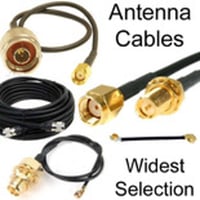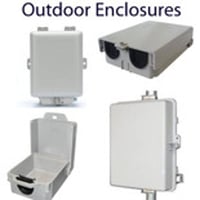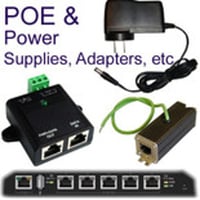DIN & mini-DIN Adapters & Cables
DIN and Mini DIN Connectors:
DIN types are 7/16, which is the standard size, and 4.3/10, which is the mini-DIN version.
The 7/16 DIN connector
The 7/16 DIN connector is a large 50-ohm threaded coaxial connector that is manufactured in accordance with Deutsches Institut für Normung (DIN) standards. 7/16 DIN connectors have exceptional power handling making them a connector of choice in telecommunications. Its frequency range of up to 7.5 GHz makes it particularly useful in cellular antenna systems and arrays.
The term 7/16 refers to the dimensions of this radio frequency connector:
- '7' refers to the 7-millimeter diameter of the connector's center conductor.
- '16' is the 16-millimeter internal diameter of the outer conductor.
7/16 DIN connectors were developed in the 1960s by the European company SPINNER GmbH and were previously known as a military 'special'. They were widely used in Europe and later adopted in the US and defined by the international standard IEC 61169-4.
Physical specifications of the 7/16 DIN connector
The 7/16 DIN connector is comprised of male and female connectors. Here are its key physical features:
- The weight of the 7/16 connector is between 150 and 200 grams.
- The body of the 7/16 DIN connector is made of silver-plated brass
- It is a threaded connector with 29 mm by 1.5 mm pitch threading.
- The diameter of the center conductor is 7 mm
- The internal diameter of the outer conductor is 16 mm
- The Male 7/16 DIN connector has internal threads and a hex nut on its body. Its center conductor is made from silver-plated brass.
- The Female 7/16 DIN connector has a barrel-shaped body with external threading. Within the connector, it carries a Berylium copper receptacle as its center conductor.
- 7/16 DIN connectors also routinely carry a silicone rubber gasket and annealed copper crimp ferrule.
Coaxial DIN connectors are mated by screw coupling with the male connector screwing down onto the female connector. A wrench can be used on the hex nut of the male connector to tighten the connector to the appropriate torque. The durability of this connector means that it is rated for a minimum of 500 mating cycles.
Electrical specifications of the 7/16 DIN connector
The 7/16 DIN connector is rated for its outstanding electrical performance at frequencies up to a maximum of 7.5 GHz. Here are the key electrical specs of this connector:
- The characteristic impedance of the 7/16 DIN connector is 50 ohms.
- Its working voltage has a maximum root mean square voltage of 2700
- The dielectric withstanding voltage 7/16 DIN connector has a maximum root mean square voltage of 4000.
- The VSWR is 1.3.
- The average peak power is 3 kW.
- 7/16 DIN connectors have a shielding effectiveness of over 125 decibels.
Coaxial cable for the 7/16 DIN connector
7/16 DIN connectors need to be carefully assembled with low-PIM coaxial cable with a diameter between 0.141 to 0.545 inches (0.36 to 1.38 centimeters). Connectors can be attached to the cables by crimping, soldering, or clamping. Cables used for 7/16 DIN connectors are usually low loss and may even be corrugated. Common pairings include:
- LMR 400
- LMR 400 FR
- LMR 600
- SPO-375
- SPO-375 corrugated
- RG 214
- RG 213
Why are 7/16 DIN connectors important?
This is a large and rugged RF connector that physically and electrically outperforms other weatherproof and rugged non-flange connectors like the N connector or TNC connector in harsh conditions. 7/16 DIN connectors threaded mated connection can withstand vibrations, making it ideal for broadcast communication or radio base stations applications.
Its notable power handling is achieved by a large diameter center pin that tolerates heating and oxidation without voltage breakdown, even with sustained use at high frequencies. Cleaned and properly aligned, this low-PIM connector performs for high-power applications that operate at lower frequencies or use short-pulse operation. DIN 7/16 connectors are also resistant to interference and intermodulation rejection at microwave frequencies.
7/16 DIN connector applications
This is a key connector for use in complex, high-power antenna systems with a high electrical load from multiple transmitters using a single antenna or where a large number of transmitting antennas are clustered.
7/16 DIN connectors are advantageous in telecommunications because they produce fewer inter-modulation distortion products when used with low passive intermodulation (PIM) rated antennas, meaning their performance is reliable in demanding RF sites or trunking systems. Regular N connectors cannot deliver the same level or quality of performance.
Other applications of 7/16 DIN connectors include:
- Bluetooth
- Satellite Receivers
- Satellite radio
- High-power communication devices
- Antenna Mounts
- Machine-to-machine (M2M) communications
Larger coaxial DIN connectors
Larger coaxial DIN connectors are less common than the 7/16 DIN connectors but are used for even higher-power applications in the cellular and broadcast industries. They also require large diameter coaxial cable and are often used in custom assemblies. Here are two larger coaxial connectors in the same DIN series:
13/30 DIN connector
Physical specifications of the 13/30 DIN connector
The 13/30 DIN connector is comprised of male and female connectors. Here are its key physical features:
- The weight of the 13/30 connector is 460 grams.
- It is a threaded connector with 50 mm by 3 mm pitch threading.
- The diameter of the center conductor is 13 mm.
- The internal diameter of the outer conductor is 30 mm.
- The Male 13/30 DIN connector has internal threads and a hex nut on its body. Its center conductor is made from silver-plated copper.
- The Female 13/30 DIN connector has a barrel-shaped body with external threading. Within the connector, it carries a silver-plated copper receptacle as its center conductor.
- 13/30 DIN connectors also routinely carry a silicone rubber gasket.
Electrical specifications of the 13/30 DIN connector
- The characteristic impedance of the 13/30 DIN connector is 50 ohms.
- The maximum frequency of the 13/30 connector is 2.7 GHz
- The VSWR is 1.03.
25/58 DIN connector
This is an even larger RF connector which is extremely rare. It is structurally similar to the 7/16 DIN connector but has four times its power handling.
Mini-DIN Connectors
Mini-DIN coaxial connectors are smaller radio frequency connectors that have a similar or identical design to the 7/16 DIN connector.
Mini-DIN connectors are used as an alternative to type N or 7/16 DIN connectors in a wide range of wireless networking applications. They are advantageous for applications that require low PIM and low attenuation. They are distinct from the multi-pin Mini-DIN connectors used in computing for connecting keyboards or other hardware.
4.1/9.5 Mini-DIN Connectors
4.1/9.5 Mini-DIN connectors are 50-ohm connectors that have a 4.1-millimeter diameter center conductor and a 9.5-millimeter internal diameter of the outer conductor. They were standardized in 2007 and conform to IEC 60169-11. Over the last decade, it has surpassed the DIN 7/16 connector because of its smaller size and weight. Though large when compared to common medium, miniature, and subminiature connectors, they are a scaled-down version of the 7/16 DIN connector.
Physical specifications of the 4.1/9.5 DIN connector
The 4.1/9.5 DIN connector is comprised of male and female connectors. They mate by screw coupling and are rated for a minimum of 500 mating cycles. Here are the key physical features:
- The weight of the 4.1/9.5 connector is approx. 45 grams.
- The body of the 4.1/9.5 DIN connector is made of brass with nickel or silver plating.
- It is a threaded connector with 20 mm by 1.6 mm pitch threading.
- The diameter of the center conductor is 4.1 mm
- The internal diameter of the outer conductor is 9.5 mm
- The Male 4.1/9.5 DIN connector has internal threads and a hex nut on its body. Its center conductor is made from silver-plated brass.
- The Female 4.1/9.5 DIN connector has a barrel-shaped body with external threading. Within the connector, it carries a brass or phosphor bronze receptacle as its center conductor.
- 4.1/9.5 DIN connectors also routinely carry a silicone rubber gasket and annealed copper crimp ferrule.
Electrical specifications of the 4.1/9.5 DIN connector
The 4.1/9.5 DIN connector is rated for its outstanding electrical performance at frequencies up to a maximum of 14 GHz. Here are the key electrical specs of this connector:
- The characteristic impedance of the 4.1/9.5 DIN connector is 50 ohms.
- Its working voltage has a maximum root mean square voltage of 1700
- The dielectric withstanding voltage of the 4.1/9.5 DIN connector has a maximum root mean square voltage of 2000.
- The VSWR is 1.2.
- 4.1/9.5 DIN connectors have a shielding effectiveness of over 165 decibels.
Applications of the 4.1/9.5 DIN connector
The predominant applications of this connector are cellular base stations, distributed antenna systems (DAS), and small cells. Cellular networking hardware components that use 4.1/9.5 DIN connector include:
- Feeder Cables
- Combiners
- Filters
- Jumpers
- Diplexers
- Triplexers
4.3/10 Mini-DIN Connectors
The 4.3/10 Mini-DIN connector is an updated version of the 4.1/9.5 connector that is favored for its superior performance. They are also compact and reduce weight and increase equipment density in the equipment they are used in. 4.3/1.0 connectors are used widely in high-performance communications systems, especially in the cellular sector. The 4.3/10 connector has an operating range of DC to 12 GHz, low PIM, and low return loss.
1.0/2.3 Mini-DIN Connectors
This is one of the smallest Mini-DIN connectors and is mated by push-pull coupling rather than screwing. This 75-ohm connector is designed for component dense applications and is primarily used in 12G-SDI Broadcast Video. It is small enough to be used in RG 6 or RG 179 cables assemblies.
Other classes of DIN connectors
Non-coaxial DIN connectors are high-frequency, multi-pin, circular electrical connectors that conform to the German standards of the Deutsches Institut für Normung (DIN). This class of connectors was first standardized in the 1970s.
These connectors were originally standardized by DIN for transmitting analog audio signals, with subsequent expansion of the range of applications to include analog video, digital interfaces, computing, networking, and power connections. Though they look similar to XLR connectors, they are distinct and incompatible with them.
The DIN family of circular connectors is characterized by the following features:
- The connectors are round with a circular cross-section.
- 13.2 mm diameter metal shield with a characteristic notch on male DIN connectors or plugs. This restricts the mating of the connector to a specific orientation.
- Male connectors carry multiple pins, usually between three and eight that are arranged in a variety of patterns.
- Some older DIN connectors are unshielded with only two pins.
- The straight round pins of the connector have a diameter of 1.45 mm in diameter.
- The pins are equally spaced at 45°60°, 72°, or 45° angles.
- 3-pin connectors can fit 3 or 5-pin sockets, and 5-pin connectors can fit 7 or 9-pin sockets.
Specific DIN connectors are identified by the document number of the standard that applies to the connector. DIN connectors are further classified according to the pin configuration they have:
- 3-pin at 90° and 5-pin at 45° (DIN 41524 / IEC/DIN EN 60130-9)
- 5-pin and 6-pin at 60° (DIN 45322)
- 7-pin at 45°(DIN 45329 / IEC/DIN EN 60130–9)
- 8-pin at 45° (DIN 45326 / IEC/DIN EN 60130-9)
DIN connector sockets
DIN connector male plugs usually fit into mounted sockets with complementary holes for the pins. A variety of mounting methods are used that accommodate straight or right-angle connectors:
- Flange-mounting: here, the DIN connectors are bolted or riveted into place panels after passing through holes in the panel.
- PCB mounting: DIN sockets insert into pre-drilled holes in the PCB, with or without soldering into position.
- Surface-mount technology: facilitates the soldering of DIN sockets to the PCB surface without any pre-drilled holes. This is a preferred mounting arrangement for high-frequency assemblies.
Key DIN connector standards
Here are some notable DIN connector standards:
DIN 41524
Specifies circular connectors that are commonly used for audio and digital applications. They have between two and seven cavity/pin arrangements.
DIN 41612
Rectangular electrical connectors that are routinely used in rack-based applications. It can be used to connect circuit boards and backplanes. These DIN connectors include power connectors and signal connectors. They are known for good power handling and low-contact resistance.
DIN 41652
D-subminiature Pin-in-Paste connectors used for computer data and video applications. These rack and panel connectors have a distinctive D-shaped shield with 9, 15, 25, 37, or 50 pins arranged in parallel rows for complementary sockets.
DIN 41585
Automotive coaxial connectors that are often used with original equipment and aftermarket car radios. They provide an interface for connections that connect an aerial with a radio frequency connector and coax to an ISO socket. This single pin connector is also known as a Motorola connector and is usually paid with G58.







